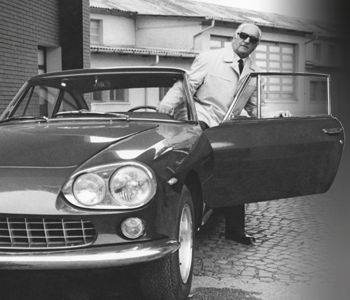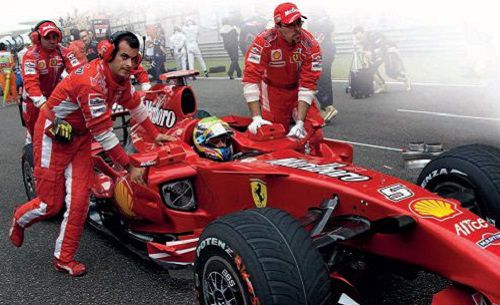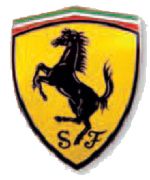Enzo Ferrari forged his reputation on the race track before becoming a car manufacturer in 1940, so it is no surprise that the marque founded by the fiery Italian has the most successful record in Formula 1. As well as being a major name in motor sport, Ferrari has made many of the world’s fastest, most desirable road cars.

The history Ferrari began with: ENZO FERRARI was born in 1898 near Modena, northern Italy. As a boy, Enzo went to motor races with his father and brother. He quickly fell in love with the sport and decided that when he grew up he would emulate his hero, Felice Nazarro, and become a racing driver.
Enzo made his competitive debut in 1919, and the following year he became a works driver for Alfa Romeo. During his racing career, Enzo Ferrari recorded many victories and was awarded the honorary titles of Cavaliere and Commendatore by the Italian state for his achievements.
In 1929 Enzo founded the Scuderia Ferrari racing team, using the cavallino rampante (prancing horse) as its logo. The Scuderia took over the running of Alfa Romeo’s racing team in 1933. When Alfa Romeo brought its racing operation in-house again in 1937, Ferrari was appointed racing manager, but he did not stay long.

Ferrari 365GTS-4 Daytona Spyder
Spyders were ever produced by Ferrari, and are highly prized by enthusiasts. Cashing in on this, many hardtop 365GTBs have since been modified like this one, with the roof removed to give the appearance of a Spyder.
The terms of Enzo Ferrari’s departure prevented him from using his own name in motor racing, so he called the company he founded in 1940 Auto Avio Costruzione. This new company manufactured parts for the aircraft industry, but Enzo Ferrari continued to follow his interest in motor racing, and he was soon building competition cars based on Fiat chassis.
In 1943 the company moved to Maranello, just outside Modena, where it is still based today. The first Ferrari car, the 125S, was announced in 1946 and went on sale the following year. Success soon followed, initially in sports-car racing, with Ferrari winning Italy’s Mille Miglia and Targa Florio in 1948, and France’s Le Mans 24-hour race in 1949.
Ferrari’s first victory in Grand Prix racing came in 1951, and Alberto Ascari won the Formula 1 World Championship for Ferrari in 1952 and 1953. During the next six decades of competition, Ferrari won almost every trophy in motor racing. Maranello cars won Le Mans nine times, the U.S.

Ferrari 275GTB4 1966
All-independent suspension, four camshafts, and six Weber carburetors helped to make this model a fearsome road/race machine.
Sebring 12-hour race nine times, the Mille Miglia eight times, and the Targa Florio six times. In Formula 1, Ferrari was an almost constant presence right from the start of the World Championship era in 1950, winning the constructors’ title 16 times and taking nine drivers to 15 individual world titles. Along the way it won over 200 Formula 1 races, more than any other team in the World Championship’s history.
Ferrari’s success in motor racing was built on focused effort from the best engineers and drivers, inspired by the determination of the man in whose name they were racing. Failure was not tolerated, and lost races were followed by a post-mortem meeting in the company boardroom, which was nicknamed the “museum of mistakes.”
Enzo Ferrari would hurl broken car parts across the table at startled engineers, and he often set two teams of engineers working independently on rival projects to drive development harder and faster. Relationships between Ferrari and his team members were often frosty. Paying customers were sometimes treated with similar disdain.

Chinese Grand Prix, Shanghai, 2007
Ferrari has had an unparalleled record in Formula 1 in recent years. Here, mechanics push driver Felipe Massa to the starting grid at the 2007 Chinese Grand Prix.
The successful industrialist Ferruccio Lamborghini was so incensed at his treatment when he complained about the quality of the Ferrari he had just bought that he started his own car company in 1963, which became one of Ferrari’s biggest road-car rivals. Such incidents added to the mystique of Ferrari and the man behind the company.
Meanwhile, the amazing performance and superb looks (styled by Italian design company Pininfarina) of Ferrari’s road models, including the V12-engined 275GTB/4 and 365GTB/4 Daytona, and the V6 Dino 206 and 246, were matched by few other cars.
Ferrari was too small to survive indefinitely as a wholly independent company. In the 1960s an approach from the U.S. giant Ford very nearly led to investment in Ferrari and the formation of two new companies: Ford-Ferrari, which would build road cars, and Ferrari-Ford, which would concentrate on racing. Enzo Ferrari put a stop to the deal at the last minute.

The Ford management, feeling slighted by Ferrari’s rebuttal, vowed to beat him at his own game and instituted the GT40 sports-car racing program. The GT40 trounced Ferrari at Le Mans, winning the race from 1966 to 1969. Ferrari did later join up with the major Italian manufacturer Fiat, which took a 50 percent shareholding in 1969.
The financial stability this gave Ferrari led to further great exploits on the race track, including success in sports-car racing and two World Championship wins in Formula 1 for Niki Lauda in the mid-1970s. It also allowed Ferrari to develop a series of breathtaking supercars, including the 1970s’ 365BB and 512BB, the Testarossa and F40 of the 1980s, the 1990s’ F50, and the 2002 Enzo, named after the company founder.
After Enzo Ferrari’s death in 1988, Fiat raised its shareholding to 90 percent, enabling Ferrari to produce more cars than ever and improve quality. In Formula 1, Ferrari had suffered a relatively barren period since Jody Scheckter’s world-title win in 1979, but its fortunes were boosted when driver Michael Schumacher and engineer Ross Brawn joined the team in 1996.

Dino Ferrari 246GT 1968
Notionally, Dino was a separate, junior Ferrari marque, but this delectable V6, mid-engined two-seater was every inch the thoroughbred, with superb handling.
Ferrari and Schumacher together secured an unprecedented five driver’s titles and six constructor’s championships between 1999 and 2004. Kimi Räikkönen added another driver’s title in 2007, and Felipe Massa was nearly victorious in 2008. Today, Ferrari’s range of cars is more extensive than ever, encompassing two- and four-seater front-engined V12s (the 599 and 612 models) and a pair of V8-engined cars (the mid-engined 458 Italia and the front-engined California). For Ferrari, the challenge will be to remain relevant in an age of concern over CO2 emissions and energy consumption, without compromising a long history of very fast, very beautiful, motor cars.